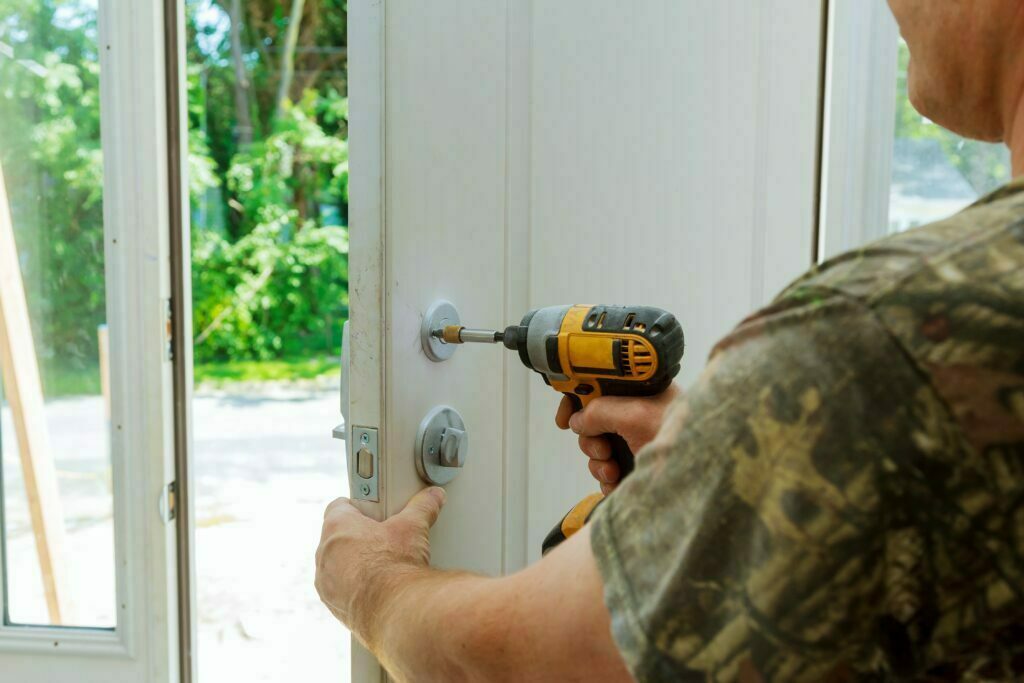So you’ve found yourself with a broken door and you’re wondering how to fix it. Whether it’s a squeaky hinge, a loose handle, or a crack in the frame, a broken door can be not only frustrating but also a potential security issue. But fear not, because in this article, we will walk you through step-by-step instructions on how to tackle those common door repairs and have your door functioning like new in no time. So let’s roll up our sleeves and get to work on fixing that broken door!
Inspecting the Door
When faced with a broken door, the first step is to inspect it thoroughly to identify the problem. By taking the time to assess the situation, you can determine the necessary repairs needed to get your door functioning properly again.
Identify the Problem
Start by examining the door and noting any visible issues. Is the door sagging? Does it stick when you try to open or close it? Are there any cracks or damage to the door panel? Is the lock malfunctioning? Identifying the specific problem will help guide you in the repair process.
Check the Hinges
Inspect the door hinges closely. Loose or damaged hinges are a common cause of door problems. Look for any screws that may have become loose or stripped. Tighten them with a screwdriver and check if this resolves the issue. If the hinges are damaged beyond repair, you may need to replace them.
Examine the Door Frame
Next, examine the door frame for any signs of damage or misalignment. Over time, door frames can shift or become warped, causing the door to stick or not close properly. If you notice any cracks, gaps, or shifting, it may be necessary to adjust or replace the door frame.
Inspect the Door Handle
A faulty door handle can make it difficult to open or close the door. Check if the handle is loose or if any components are broken. If the issue is minor, tightening or replacing screws might solve the problem. However, if the handle is severely damaged, it may need to be replaced entirely.
Evaluate the Lock
Lastly, evaluate the lock on the door. If the lock is sticking, not engaging properly, or becoming difficult to turn, it could be a sign of a faulty lock mechanism. In some cases, the lock may just require lubrication or adjustment. However, if the lock is beyond repair, it may be necessary to replace it altogether.
Repairing the Door
Once you have inspected the door and identified the problems, it’s time to start the repair process. Depending on the issues you discovered, there are specific steps you can take to fix the door and restore its functionality.
Fixing Loose Hinges
If you found that the hinges are loose, start by tightening the screws on the hinges using a screwdriver. Ensure the screws are securely fastened to provide proper support to the door. If the screw holes are stripped, you can try using longer screws or filling the holes with wooden toothpicks coated in wood glue for a more secure grip.
Adjusting the Door Frame
To address a misaligned or warped door frame, you may need to make some adjustments. Begin by removing the door from the frame by unscrewing the hinges. Use a chisel and hammer to carefully shave off any excess wood or straighten out any misaligned sections of the frame. Secure the frame back into place and re-attach the door to test its alignment.
Repairing Damaged Door Panel
If you noticed cracks or damage on the door panel, you can repair it using wood putty. Clean the damaged area thoroughly, removing any loose pieces of wood. Apply the wood putty to the damaged area, using a putty knife to smooth it out. Allow the putty to dry completely before sanding it down and painting or staining the repaired section to match the rest of the door.
Replacing the Door Handle
When dealing with a faulty door handle, it is often best to replace it altogether. Remove the old handle by unscrewing the mounting screws. Take note of the handle’s dimensions and style to ensure the replacement handle is compatible. Install the new handle by aligning it with the existing holes and tightening the mounting screws. Test the functionality of the new handle by opening and closing the door multiple times.
Fixing a Faulty Lock
If the lock on your door is malfunctioning, it might need some adjustments or lubrication. Start by removing the lock mechanism from the door according to the manufacturer’s instructions. Clean any dirt or debris from the lock components and apply lubricant to the keyway and moving parts. Reassemble the lock and test it to determine if the issue has been resolved. If the lock still doesn’t function properly, consider replacing it with a new lockset.
Replacing Parts
In some cases, repairing the door may not be enough, and certain parts of the door may need to be replaced entirely. Follow these steps to ensure a successful replacement.
Determine Replacement Parts
Identify the specific parts that need replacement, such as hinges, door frames, door panels, door handles, or locks. Take measurements and note any unique features or requirements to ensure you purchase the correct replacement parts.
Removing Old Hinges
To replace hinges, start by removing the screws that hold the old hinges in place. Carefully take out the old hinges, ensuring not to damage the door or frame. Clean the area and prepare it for the installation of the new hinges.
Installing New Door Frame
Replacing a door frame can be a more extensive task. Begin by removing the old frame, including the door and hinges. Take precise measurements of the door opening to ensure a proper fit for the new frame. Install the new frame following the manufacturer’s instructions, ensuring it is securely anchored and aligned.
Replacing a Damaged Door Panel
Replacing a damaged door panel involves removing the old panel and installing a new one. Remove the molding around the door panel and unscrew any fasteners. Carefully dislodge the damaged panel and replace it with a new panel of the same dimensions. Reinstall the molding and ensure it is securely fastened.
Installing a New Door Handle
To install a new door handle, start by removing the old handle according to the previous steps mentioned. Carefully align the new handle with the existing holes and secure it in place with the provided screws. Verify the handle’s functionality by testing its operation.
Replacing a Faulty Lock
To replace a faulty lock, start by removing the existing lockset from the door. Follow the manufacturer’s instructions for disassembly and removal. Install the new lockset according to the provided guidelines, ensuring a secure fit. Test the lock to ensure it operates smoothly.
Sealing and Finishing
After making the necessary repairs or replacements to the door, it’s essential to seal and finish the door properly to enhance its durability and appearance.
Weatherstripping the Door
To prevent drafts and improve energy efficiency, apply weatherstripping to the edges of the door. Measure and cut the weatherstripping to fit the door, ensuring a proper seal. Peel off the adhesive backing and press the weatherstripping firmly into place.
Applying Wood Putty
If any areas of the door required repairs, apply wood putty to fill in any cracks, gaps, or holes. Use a putty knife to smooth out the putty and ensure it is flush with the surrounding surface. Allow the putty to dry completely before sanding it down for a smooth finish.
Sanding and Smoothing
Before applying any paint or stain, sand the entire surface of the door to create a smooth and even texture. Use a medium grit sandpaper to remove any imperfections or rough spots. Follow up with a finer grit sandpaper for a polished finish.
Painting or Staining the Door
Choose a paint or stain color that complements your home’s aesthetic and carefully apply it to the door using a brush or roller. Ensure you paint or stain all sides of the door, including the edges. Allow sufficient drying time between coats and follow the manufacturer’s instructions for the specific paint or stain you choose.
Applying Protective Finish
Once the paint or stain has dried, apply a protective finish, such as a clear varnish or sealer, to protect the door from moisture, UV rays, and everyday wear and tear. Follow the manufacturer’s instructions for application and drying time to ensure optimal protection.
Preventive Maintenance
To prevent future door issues and prolong the lifespan of your door, regular preventive maintenance is key. By following these maintenance tips, you can keep your door in excellent condition.
Regularly Lubricate Hinges and Hardware
To ensure smooth operation, lubricate the hinges, door handle, and lock periodically. Use a silicone-based spray or lubricant specifically designed for door hardware. Apply a small amount to the moving parts and wipe away any excess.
Keep the Door Clean
Regularly clean the door with mild soap and water to remove dirt, dust, and debris. Avoid using harsh chemicals or abrasive cleansers that may damage the door’s finish. Gently scrub the surface and dry it thoroughly to prevent moisture damage.
Check and Adjust the Door Alignment
Regularly check the door’s alignment and adjust as needed to prevent sticking or misalignment. If you notice the door is no longer closing properly, use the necessary techniques mentioned earlier, such as adjusting the hinges or the door frame, to realign the door.
Inspect and Tighten Screws and Bolts
Periodically inspect all screws and bolts on the door for signs of loosening. Use a screwdriver or wrench to tighten any that may have come loose. Loose hardware can compromise the door’s stability and performance.
Maintain Weatherstripping
Check the condition of the weatherstripping regularly. Replace any worn or damaged weatherstripping to maintain a proper seal. Ensure the weatherstripping is clean and free from debris to ensure its effectiveness.
Calling for Professional Help
While many door repairs can be tackled as a DIY project, there are situations where it’s best to call in professionals. Knowing when to seek professional assistance and finding a reliable door repair service is vital.
Know When to Seek Professional Assistance
If you encounter complex door issues, lack the necessary tools or expertise, or are unsure about the repair process, it is wise to seek professional assistance. Professionals have the knowledge and experience to handle a wide range of door problems efficiently and safely.
Find a Reliable Door Repair Service
When searching for a door repair service, consider their reputation, experience, and customer reviews. Look for companies that specialize in door repair or offer a comprehensive range of services. It’s crucial to choose a reliable and trustworthy service provider to ensure quality workmanship.
Ask for Recommendations
Seek recommendations from friends, family, or neighbors who have previously used door repair services. Their personal experiences can help you find trustworthy professionals who have proven their expertise in the field.
Get Multiple Quotes
To ensure a fair price and quality service, obtain multiple quotes from different door repair services. Compare the costs, warranties, and services offered to make an informed decision. Remember that the lowest price isn’t always the best choice; consider the value and reputation of the company as well.
Discuss the Repair Scope and Costs
Once you have chosen a door repair service, discuss the scope of the repair and the associated costs. Ensure you have a clear understanding of the work that will be done and any warranties or guarantees offered. Request a written estimate detailing the repair process and associated expenses before proceeding.

Essential Tools and Materials
To successfully repair and maintain your door, the following tools and materials are often necessary:
- Screwdriver Set
- Hammer
- Chisels
- Wood Putty
- Sandpaper
- Paintbrushes or Rollers
- Paint or Stain
- Door Hardware
- Lockset
- Weatherstripping
Having these essential tools and materials readily available will make the repair process smoother and more efficient.
Considerations for Different Door Types
Depending on the type of door you have, certain considerations may need to be taken into account during the repair process. Here are some tips for specific door types:
Repairing a Wooden Door
For wooden doors, pay close attention to any signs of moisture damage or rot. If necessary, replace any rotted or damaged sections and thoroughly seal the wood to prevent future deterioration.
Fixing an Aluminum Door
When working with an aluminum door, be cautious not to scratch or dent the surface. Use appropriate tools and gentle techniques to prevent any cosmetic damage.
Mending a Glass Door
Repairing a glass door requires special care to avoid injury and damage. If the glass is broken or cracked, it is best to consult a professional who specializes in glass door repair or replacement.
Restoring a Sliding Door
Sliding doors may require adjustments to the rollers or tracks for smooth operation. A dry lubricant can also be applied to ensure easy sliding. If the door is sticking or not sliding properly, consult a professional for assistance.
Repairing a Screen Door
When dealing with a screen door, check for any torn or damaged screens that may need replacement. Additionally, inspect the hinges and hardware for any signs of wear or damage.

Safety Precautions
While repairing a door can be a rewarding DIY project, it is crucial to prioritize safety. Take the following precautions to avoid accidents and ensure a safe repair process.
Wear Protective Gear
When working with tools or handling potentially hazardous materials, wear protective gear such as safety glasses, gloves, and closed-toe shoes. This will protect you from injuries and potential hazards.
Ensure Proper Ventilation
If using paint, stain, or any products with strong fumes, ensure the area is well-ventilated. Open windows or use fans to circulate fresh air and prevent inhaling harmful chemicals.
Use Caution with Power Tools
When using power tools, always read and follow the manufacturer’s instructions. Use the appropriate safety precautions, such as wearing goggles and avoiding loose clothing that could get caught in the machinery.
Secure the Area
Ensure the area where you’re working is clean and free from clutter to minimize the risk of tripping or falling. Secure any rugs or obstacles that may cause accidents or impede your movement.
Keep Children and Pets Away
While repairing or replacing a door, it’s best to keep children and pets away from the work area for their safety and to prevent distractions. This will allow you to focus on the task at hand and avoid accidents.
Conclusion
Repairing a broken door can seem like a daunting task, but with the right approach and tools, it can be accomplished successfully. By thoroughly inspecting the door, identifying the problems, and following the appropriate repair or replacement steps, you can restore your door’s functionality and appearance.
Remember to prioritize safety throughout the repair process and take preventive measures to maintain your door’s condition. Regular maintenance and timely repairs can help extend the lifespan of your door, saving you time and money in the long run.
Once you have completed the necessary repairs and finishing touches, take the time to evaluate the repaired door and test its functionality. Appreciate the accomplishment of a job well done and know that you have improved the functionality and aesthetics of your door. With proper care and maintenance, your door will continue to serve you well for years to come.



